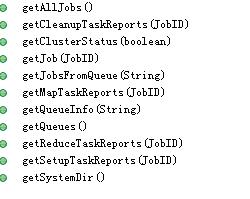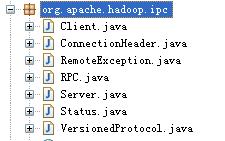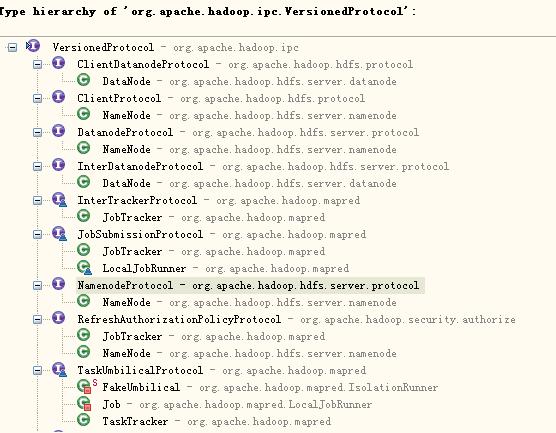Hadoop的各个服务间,客户端和服务间的交互采用RPC方式。关于这种机制介绍的资源很多,也不难理解,这里不做背景介绍。只是尝试从Jobclient向JobTracker提交作业这个最简单的客户端服务器交互的代码中,去跟踪和了解下RPC是怎么被使用的。不同于准备发表博客时搜索的几篇博文,试图通过一种具体的场景来介绍,属于比较初级。其他DataNode和Namenode之间,Tasktracker和JobTracker之间的交互基本也都一样。为了引用的代码篇幅尽可能少,忽略了代码中写日志(包括Metrics)、某些判断等辅助代码。
1 RPC客户端请求(从JobClient 的jobSubmitClient 入手)
Jobclient包含一个JobSubmissionProtocol jobSubmitClient类型的句柄,从作业提交一节的介绍中看到Jobclient的计划所有重要操作都是通过jobSubmitClient来完成的。包括

所有这些方法都在JobSubmissionProtocol接口中定义。在0.20.1的时候已经到Version 20了,在2.2.0好像到了Version 40了,说明功能一直在增强。
客户端的某个方法调用如何会调用到服务端的方法呢?在客户端机器上调用JobClient的getAllJobs(),怎么调用到了服务端JobTracker的getAllJobs()。这也是我尝试讲明白的核心内容。为了体现代码的一步一步分析总结在最后。可能循序渐进的作用没起到,还会笔记读起来笔记乱,感受有点不太好可能:-(。
首先看客户端JobClient中的jobSubmitClient初始化方法。在JobClient的init方法中判断不是local的方式则会调用createRPCProxy方法,进而调用RPC的getProxy方法。方法连接对应IP的服务器。比较客户端和服务端的RPC版本一致,返回一个JobSubmissionProtocol类型的句柄,抛出VersionMismatch异常。

private JobSubmissionProtocol createRPCProxy(InetSocketAddress addr, Configuration conf) throws IOException { return (JobSubmissionProtocol) RPC.getProxy(JobSubmissionProtocol.class, JobSubmissionProtocol.versionID, addr, getUGI(conf), conf, NetUtils.getSocketFactory(conf, JobSubmissionProtocol.class)); } public static VersionedProtocol getProxy(Class<?> protocol, long clientVersion, InetSocketAddress addr, UserGroupInformation ticket, Configuration conf, SocketFactory factory) throws IOException { VersionedProtocol proxy = (VersionedProtocol) Proxy.newProxyInstance( protocol.getClassLoader(), new Class[] { protocol }, new Invoker(addr, ticket, conf, factory)); long serverVersion = proxy.getProtocolVersion(protocol.getName(), clientVersion); if (serverVersion == clientVersion) { return proxy; } else { throw new VersionMismatch(protocol.getName(), clientVersion, serverVersion); } }
注意到调用了java的反射代理,在构建VersionedProtocol的时候Proxy.newProxyInstance方法初始化了一个Invoker类型的对象。
该对象是org.apache.hadoop.ipc.RPC.包下Server类的一个内部类。
static class Invoker implements InvocationHandler
这下明白了!基于java的reflect机制提供的一种Proxy使用方式。InvocationHandler这个Interface的作用就是把proxy 上的方法调用派发到实现了InvocationHandler的类上来。即Jobclient上中jobSubmitClient的任何调用都会派发到这个Invoker上来。
那么Invoker中做了什么事情呢?Invoker类实现了InvocationHandler接口定义的唯一的invoke方法。只是把传入的调用信息,包括方面名,方法参数封装为一个invocation对象,调用用Client client对象的call方法来执行操作。

public Object invoke(Object proxy, Method method, Object[] args) throws Throwable { ObjectWritable value = (ObjectWritable) client.call(new Invocation(method, args), address, method.getDeclaringClass(), ticket); return value.get();}
了解Client的call方法,该方法的主要作用是把参数发送给指定服务端地址上的IPC server。并获取结果。构建一个Call对象,封装了请求参数(其实是Invocation封装了方法和参数的对象),创建一个连接到IPC服务器的connection,然后发送出去。(client发送请求还是有些业务的,包括Client下的几个内部类的工作,在此略去)

public Writable call(Writable param, InetSocketAddress addr, Class<?> protocol, UserGroupInformation ticket) { Call call = new Call(param); Connection connection = getConnection(addr, protocol, ticket, call); connection.sendParam(call); // send the parameter return call.value; }
客户端的主要过程总结如下:客户端Jobclient的创建一个JobSubmissionProtocol
jobSubmitClient,jobSubmitClient的所有请求都会通过Invoker封装成一个请求,通过Client的call方法发送到服务端。
2 RPC服务端处理(看Jobtracker的interTrackerServer响应请求)
接下来看法服务器是如何接收请求,Client的call将请求发送到什么样的服务器?服务器如何解释这些请求,如何响应请求的。
服务端JobTracker实现了JobSubmissionProtocol接口,因此提供了JobSubmissionProtocol定义的所有方法
public class JobTracker implements MRConstants, InterTrackerProtocol, JobSubmissionProtocol, TaskTrackerManager, RefreshAuthorizationPolicyProtocol
在JobTracker内包含一个类型org.apache.hadoop.ipc.Server的的实例interTrackerServer ,该实例其实是响应客户端的的RPC调用的服务实例。
this.interTrackerServer = RPC.getServer(this, addr.getHostName(), addr.getPort(), handlerCount, false, conf);
查看RPC的getServer方法

public static Server getServer(final Object instance, final String bindAddress, final int port, final int numHandlers, final boolean verbose, Configuration conf) throws IOException { return new Server(instance, conf, bindAddress, port, numHandlers, verbose); }
再往下看其实Server的构造函数,就是在某个Ip和端口上监听,响应客户端发起的请求。多么典型的客户端服务器模式呀。代码看上去多么想Socket通信那一套呀。看到了bindAddress,看到了port,还看到socketSendBufferSize。没错!

protected Server(String bindAddress, int port, Class<? extends Writable> paramClass, int handlerCount, Configuration conf, String serverName) throws IOException { this.bindAddress = bindAddress; this.conf = conf; this.port = port; this.paramClass = paramClass; this.handlerCount = handlerCount; this.socketSendBufferSize = 0; this.maxQueueSize = handlerCount * MAX_QUEUE_SIZE_PER_HANDLER; this.callQueue = new LinkedBlockingQueue<Call>(maxQueueSize); this.maxIdleTime = 2*conf.getInt("ipc.client.connection.maxidletime", 1000); this.maxConnectionsToNuke = conf.getInt("ipc.client.kill.max", 10); this.thresholdIdleConnections = conf.getInt("ipc.client.idlethreshold", 4000); // Start the listener here and let it bind to the port listener = new Listener(); this.port = listener.getAddress().getPort(); this.rpcMetrics = new RpcMetrics(serverName, Integer.toString(this.port), this); this.tcpNoDelay = conf.getBoolean("ipc.server.tcpnodelay", false); // Create the responder here responder = new Responder(); }
同时不小心注意到Server类的outline阵容还是很宏大的,除了一长串的方法外,还包括Call, Connection, Handler,Listener, responder 五个内部类,猜就是这些协作来完成Server的服务响应处理。

同时注意到Server中包含的如下几个重要的实例

private BlockingQueue<Call> callQueue; // queued calls private List<Connection> connectionList = Collections.synchronizedList(new LinkedList<Connection>()); private Listener listener = null; private Responder responder = null; private Handler[] handlers = null;
再看看Server的start()方法

public synchronized void start() throws IOException { responder.start(); listener.start(); handlers = new Handler[handlerCount]; for (int i = 0; i < handlerCount; i++) { handlers[i] = new Handler(i); handlers[i].start(); } }
其中,在Server的构造函数中看到了两个差不多能猜到其功能的东西:Listener & Responder。从命名上几乎就能猜到,他们分别是监听用户请求和响应用户请求的线程?应该是线程吧?居然猜对了!
先看下Listener。构造函数如下

public Listener() throws IOException { address = new InetSocketAddress(bindAddress, port); // Create a new server socket and set to non blocking mode acceptChannel = ServerSocketChannel.open(); acceptChannel.configureBlocking(false); // Bind the server socket to the local host and port bind(acceptChannel.socket(), address, backlogLength); port = acceptChannel.socket().getLocalPort(); //Could be an ephemeral port // create a selector; selector= Selector.open(); // Register accepts on the server socket with the selector. acceptChannel.register(selector, SelectionKey.OP_ACCEPT); }
重点看下线程的业务方法,即其run方法做了些啥。方法虽然很长,但是业务很典型,在服务端监听,收到数据就接收。

public void run() { SERVER.set(Server.this); while (running) { SelectionKey key = null; selector.select(); Iterator<SelectionKey> iter = selector.selectedKeys().iterator(); while (iter.hasNext()) { key = iter.next(); iter.remove(); try { if (key.isValid()) { if (key.isAcceptable()) doAccept(key); else if (key.isReadable()) doRead(key); } }
接着看下接受数据的
doAccept(SelectionKey key)和doRead(SelectionKey key)方法。
doAccept做的事情是把每一个数据连接的请求绑定到一个Connection对象上,并把Connection全部添加到connectionList集合中;doRead做的事情是对每个Connection执行readAndProcess操作。

void doAccept(SelectionKey key) { Connection c = null; ServerSocketChannel server = (ServerSocketChannel) key.channel(); // accept up to 10 connections for (int i=0; i<10; i++) { SocketChannel channel = server.accept(); SelectionKey readKey = channel.register(selector, SelectionKey.OP_READ); c = new Connection(readKey, channel, System.currentTimeMillis()); readKey.attach(c); synchronized (connectionList) { connectionList.add(numConnections, c); numConnections++; } } void doRead(SelectionKey key) { Connection c = (Connection)key.attachment(); c.setLastContact(System.currentTimeMillis()); count = c.readAndProcess(); }
需要关注下org.apache.hadoop.ipc.Server.Connection类。重点看listener doRead 中调用的readAndProcess 方法

data = ByteBuffer.allocate(dataLength); count = channelRead(channel, data); if (headerRead) { processData(); data = null; return count; } else { processHeader(); headerRead = true; data = null; } authorize(user, header);
其中的processHeader()作用是解析出通信的protocol类

header.readFields(in); String protocolClassName = header.getProtocol(); protocol = getProtocolClass(header.getProtocol(), conf);
processData的主要代码如下:

int id = dis.readInt(); Writable param = ReflectionUtils.newInstance(paramClass, conf); param.readFields(dis); Call call = new Call(id, param, this); callQueue.put(call);
读取调用Id,从读取的数据中构建参数,并构造一个Call对象,放置到BlockingQueue<Call> 类型的集合中callQueue。
至此Listener的所有功能就是接收客户端发起的请求,构造Call对象并放置到队列中等待处理。
接下来是发送响应的Responder类。
重点是processResponse,是真正的写response的地方,即把执行结果写会对应的channel。

private boolean processResponse(LinkedList<Call> responseQueue, boolean inHandler) { call = responseQueue.removeFirst(); SocketChannel channel = call.connection.channel; int numBytes = channelWrite(channel, call.response); }
Handler是处理请求的线程。
是对队列中的每个call进行处理的类。前面看Server包含的实例的时候看到了,Server包含一个Handler数组,在Server的start方法中启动了Listener,Responder线程,同时初始化了handlerCount个Handler线程并且启动
主要还是看run方法。主要是从请求队列callQueue中逐个取出call了,并进行处理。
处理过程即,对每个call,执行Server的call[ 方法,(实际的call方法是从org.apache.hadoop.ipc.RPC.Server,继承了org.apache.hadoop.ipc.Server,不是一个Server哦!这个在后面RPC类中会讲到)并调用Responder方法doRespond,把结果返回。

while (running) { final Call call = callQueue.take(); // pop the queue; maybe blocked here CurCall.set(call); value = Subject.doAs(call.connection.user, new PrivilegedExceptionAction<Writable>() { @Override public Writable run() throws Exception { // make the call return call(call.connection.protocol, call.param, call.timestamp); } } ); CurCall.set(null); setupResponse(buf, call, (error == null) ? Status.SUCCESS : Status.ERROR, value, errorClass, error); responder.doRespond(call); }
调用的setupResponse方法

private void setupResponse(ByteArrayOutputStream response, Call call, Status status, Writable rv, String errorClass, String error) DataOutputStream out = new DataOutputStream(response); out.writeInt(call.id); // write call id out.writeInt(status.state); // write status rv.write(out); call.setResponse(ByteBuffer.wrap(response.toByteArray()));
核心就一句,把执行结果写到Call中去。
顺便看下上面方法调用的Responder的doRespond方法,即把经过handler处理的带有结果的call放到对应的响应队列中,等待responder线程来逐个返回给客户端,注意看到一个,如果队列中只有一个对象时,直接调用processResponse触发把结果翻过给客户端。

void doRespond(Call call) throws IOException { { call.connection.responseQueue.addLast(call); if (call.connection.responseQueue.size() == 1) { processResponse(call.connection.responseQueue, true); } } }
即handler完成call之后就开始向客户端写call结果,但是结果可能太多,无法通过一次性发送完毕,而发送之后还要等待client接受完毕才能再发,如果现在handler在那里等待客户端接受完毕,然后再发,效率不高。解决办法是handler处理完毕之后,只向client发送一次处理结果。如果这一次将处理结果发送完毕,接下来就没有response的事情了,如果没有发送完毕,接下来response负责将剩下的处理结果发送给客户端。这样handler的并发量会大一些。详细可参照Responder线程的run方法和

writeSelector.select(PURGE_INTERVAL); Iterator<SelectionKey> iter = writeSelector.selectedKeys().iterator(); while (iter.hasNext()) { SelectionKey key = iter.next(); iter.remove(); if (key.isValid() && key.isWritable()) { doAsyncWrite(key); }

//在doAsyncWrite方法中,从key中获得Call,并对每个call执行processResponse方法。 private void doAsyncWrite(SelectionKey key) Call call = (Call)key.attachment(); processResponse(call.connection.responseQueue, false))
至此观察到服务端的工作的主要过程是:
Server启动的时候,启动一个listener线程,一个Responder线程,若干个Handler线程。
Listener线程接受客户端发起的请求(在doAccept中接收请求,并且每个请求构建一个Connection,绑定到一个SelectionKey上),读取请求数据,根据请求数据构造call对象,将Call加入队列。
Handler线程从请求队列(callQueue)中获取每个Call,进行处理,把处理结果放到对应的connection的应答队列中)(responseQueue,通过调用responder.doRespond)。
Responder线程检查负责把结果返回给客户端。(processResponse,把responseQueue队列的结果数据返回)
有一点需要继续关注一下,就是Handler中处理了客户端发起的请求,并且将结果通过Responder返回。但是并没有发现Handler是调用到了Jobtracker的方法。需要继续向下多看一点即可。
从代码看Handler的call方法调用的是org.apache.hadoop.ipc.Server.的抽象方法
public abstract Writable call(Class<?> protocol, Writable param, long receiveTime)
实际调用是org.apache.hadoop.ipc.Server的子类org.apache.hadoop.ipc.RPC.Server的call方法.
从org.apache.hadoop.ipc.RPC.Server的call方法入手,该类在是RPC类的一个静态内部类。
//传入的param其实是一个Invocation对象。根据该对象的方面明,参数声明构造Method,调用Method,得到执行结果,根据返回值得类型,构造一个Writable的对象。 Writable call(Class<?> protocol, Writable param, long receivedTime) { Invocation call = (Invocation)param; Method method = protocol.getMethod(call.getMethodName(), call.getParameterClasses()); method.setAccessible(true); Object value = method.invoke(instance, call.getParameters()); return new ObjectWritable(method.getReturnType(), value); }
重点看这一句
Object value = method.invoke(instance, call.getParameters());
即最终是调用该instance上的对应名称的方法。而instance是那个实例呢?而从Server的构造方法中得到答案。
this.interTrackerServer = RPC.getServer(this, addr.getHostName(), addr.getPort(), handlerCount, false, conf);
即最终调用到JobTracker的对应方法。
3 主要流程总结
整个调用过程总结如下:根据接口JobSubmissionProtocol动态代理生成一个代理对象jobSubmitClient,调用这个代理对象的时候;用户的调用请求被RPC的Invoker捕捉到,然后包装成调用请求,序列化成数据流发送到服务端Jobtracker的interTrackerServer实例;服务端interTrackerServer从数据流中解析出调用请求,然后根据用户所希望调用的接口JobSubmissionProtocol,通过反射调用接口真正的实现对象Jobtracker,再把调用结果返回给客户端的jobSubmitClient。
4 主要类功能描述
至此根据Jobclient通过RPC方式向JobTracker请求服务的过程就描述完毕,到此主要内容应该介绍完毕。但是看到cover的代码,发现RPC的主要功能在里面了。

为了功能完整期间,在动态的串联这些类以为,把涉及到主要类的功能做个描述,其实大部分在前面代码中也有提到。
RPC类是对Server、Client的具体化。在RPC类中规定,客户程序发出请求调用时,参数类型必须是Invocation;从服务器返回的值类型必须是ObjectWritable。RPC类是对Server、Client的包装,简化用户的使用。如果一个类需充当服务器,只需通过RPC类的静态方法getServer获得Server实例,然后start。同时此类提供协议接口的实现。如果一个类充当客户端,可以通过getProxy或者waitForProxy获得一个实现了协议接口的proxy object,与服务器端交互。
org.apache.hadoop.ipc.Server
Server.Listener: RPC Server的监听者,用来接收RPC Client的连接请求和数据,其中数据封装成Call后PUSH到Call队列。
Server.Handler: RPC Server的Call处理者,和Server.Listener通过Call队列交互。
Server.Responder: RPC Server的响应者。Server.Handler按照异步非阻塞的方式向RPC Client发送响应,如果有未发送出的数据,交由Server.Responder来完成。
Server.Connection: RPC Server数据接收者。提供接收数据,解析数据包的功能。
Server.Call: 持有客户端的Call信息。
org.apache.hadoop.ipc.Client
Client.ConnectionId:到RPC Server对象连接的标识
Client.Call: Call调用信息。
Client.ParallelResults: Call响应。
org.apache.hadoop.ipc.RPC
RPC.Invoker 对InvocationHandler的实现,提供invoke方法,实现RPC Client对RPC Server对象的调用。
RPC.Invocation 用来序列化和反序列化RPC Client的调用信息。(主要应用JAVA的反射机制和InputStream/OutputStream)
5 VersionedProtocol的其他子接口
除了JobClient和Jobtracker之间通信的JobSubmissionProtocol外,最后查看下VersionedProtocol 的继承树

Hadoop中主要服务进程分别实现了各种接口,进而向外提供各种服务,其客户端通过RPC调用对应的服务。当然此处的客户端只是指调用上的客户端。
VersionedProtocol :它是所有RPC协议接口的父接口,只有一个方法:getProtocolVersion()。其子类接口的功能分别如下。
HDFS相关
ClientDatanodeProtocol :一个客户端和datanode之间的协议接口,用于数据块恢复
ClientProtocol :client与Namenode交互的接口,所有控制流的请求均在这里,如:创建文件、删除文件等;
DatanodeProtocol : Datanode与Namenode交互的接口,如心跳、blockreport等;
NamenodeProtocol :SecondaryNode与Namenode交互的接口。
Mapreduce相关
InterDatanodeProtocol :Datanode内部交互的接口,用来更新block的元数据;
InnerTrackerProtocol :TaskTracker与JobTracker交互的接口,功能与DatanodeProtocol相似;
JobSubmissionProtocol :JobClient与JobTracker交互的接口,用来提交Job、获得Job等与Job相关的操作;
TaskUmbilicalProtocol :Task中子进程与母进程交互的接口,子进程即map、reduce等操作,母进程即TaskTracker,该接口可以回报子进程的运行状态。
6 其他博文
关于Hadoop RPC机制本身一下几篇博文讲的更细致,尤其有作者整理的流程图和类图很好:
http://blog.csdn.net/xhh198781/article/details/7268176
http://www.cnblogs.com/xuxm2007/archive/2012/06/22/2558599.html
为了转载内容的一致性、可追溯性和保证及时更新纠错,转载时请注明来自:http://www.cnblogs.com/douba/p/haddoop_rpc_jobclient_jobtracker.html。谢谢!
